AirServices Australia Case Study: HRM Challenges and Solutions
VerifiedAdded on 2022/09/21
|5
|1084
|19
Case Study
AI Summary
This case study examines the Human Resource Management (HRM) challenges faced by AirServices Australia, focusing on workforce issues within the Australian aviation industry. The study addresses key challenges such as increasing air traffic, the need for modernization, and financial constraints. It analyzes AirServices Australia's recruitment process for air traffic controllers, evaluating its effectiveness and efficiency, highlighting a low success rate of candidates. The analysis explores the limitations of the current recruitment process, emphasizing the need for improvements to meet the growing demand for air traffic controllers. The case study draws upon relevant HRM concepts and academic literature, providing a comprehensive overview of the challenges and potential solutions within the context of AirServices Australia.
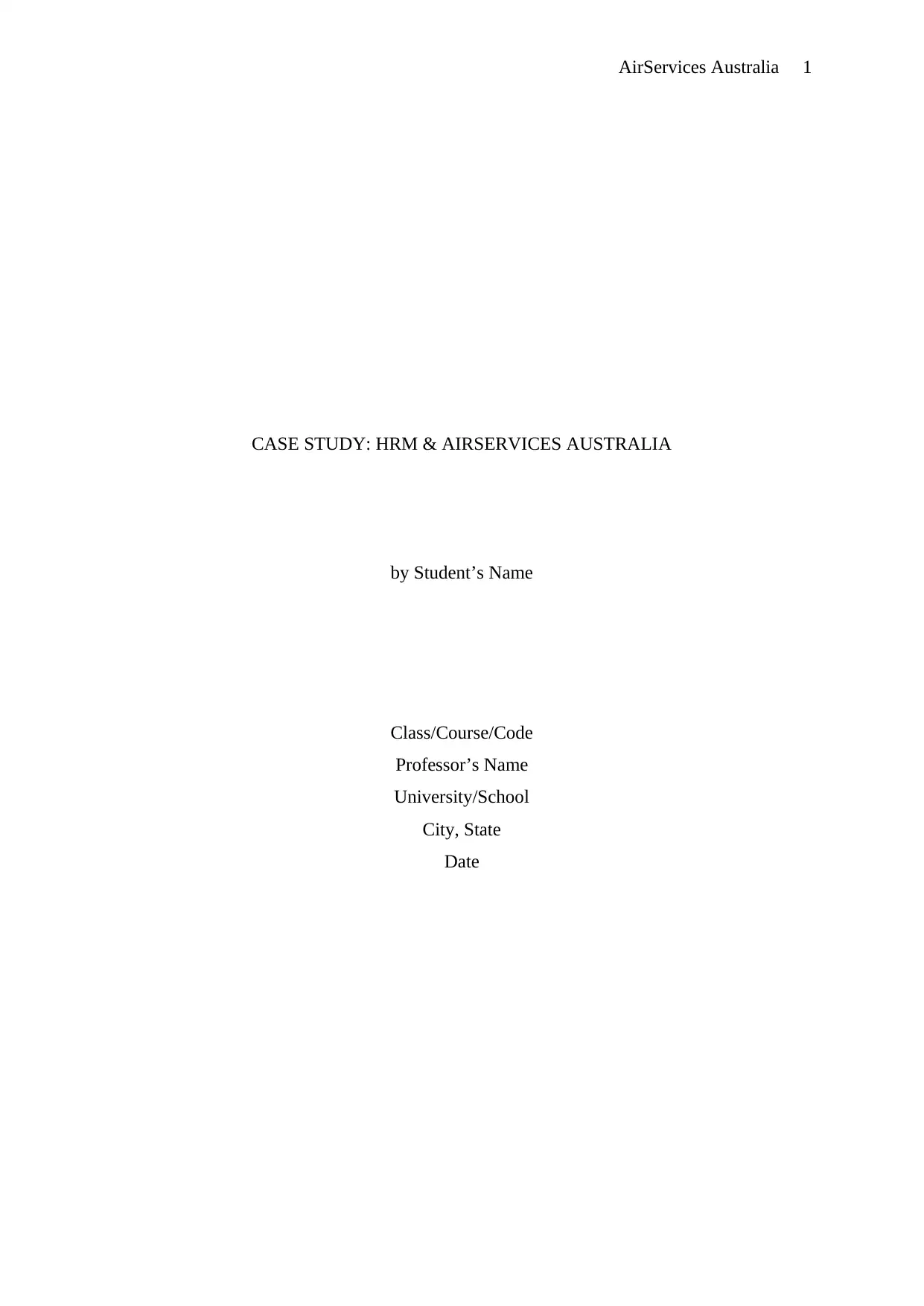
AirServices Australia 1
CASE STUDY: HRM & AIRSERVICES AUSTRALIA
by Student’s Name
Class/Course/Code
Professor’s Name
University/School
City, State
Date
CASE STUDY: HRM & AIRSERVICES AUSTRALIA
by Student’s Name
Class/Course/Code
Professor’s Name
University/School
City, State
Date
Paraphrase This Document
Need a fresh take? Get an instant paraphrase of this document with our AI Paraphraser
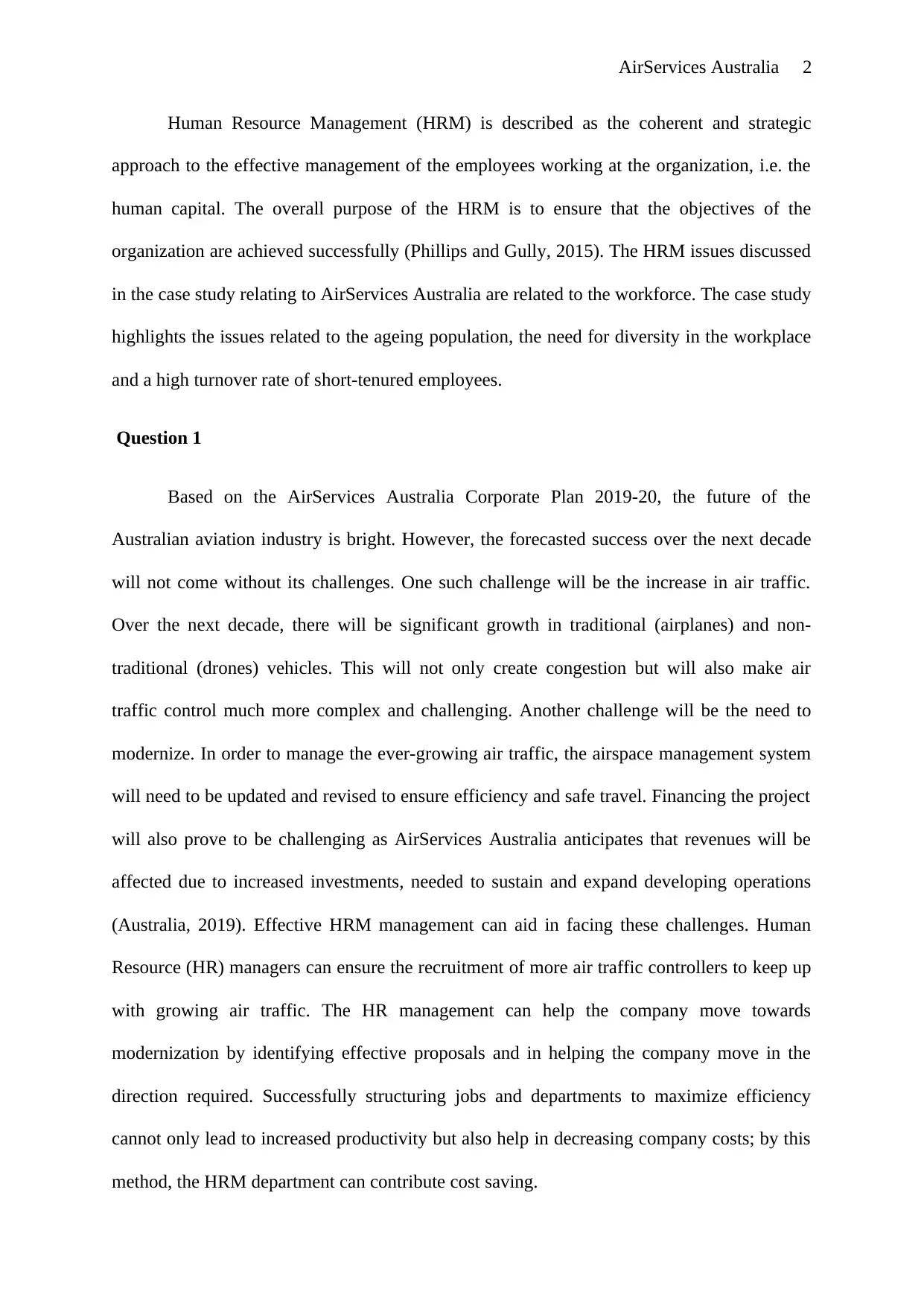
AirServices Australia 2
Human Resource Management (HRM) is described as the coherent and strategic
approach to the effective management of the employees working at the organization, i.e. the
human capital. The overall purpose of the HRM is to ensure that the objectives of the
organization are achieved successfully (Phillips and Gully, 2015). The HRM issues discussed
in the case study relating to AirServices Australia are related to the workforce. The case study
highlights the issues related to the ageing population, the need for diversity in the workplace
and a high turnover rate of short-tenured employees.
Question 1
Based on the AirServices Australia Corporate Plan 2019-20, the future of the
Australian aviation industry is bright. However, the forecasted success over the next decade
will not come without its challenges. One such challenge will be the increase in air traffic.
Over the next decade, there will be significant growth in traditional (airplanes) and non-
traditional (drones) vehicles. This will not only create congestion but will also make air
traffic control much more complex and challenging. Another challenge will be the need to
modernize. In order to manage the ever-growing air traffic, the airspace management system
will need to be updated and revised to ensure efficiency and safe travel. Financing the project
will also prove to be challenging as AirServices Australia anticipates that revenues will be
affected due to increased investments, needed to sustain and expand developing operations
(Australia, 2019). Effective HRM management can aid in facing these challenges. Human
Resource (HR) managers can ensure the recruitment of more air traffic controllers to keep up
with growing air traffic. The HR management can help the company move towards
modernization by identifying effective proposals and in helping the company move in the
direction required. Successfully structuring jobs and departments to maximize efficiency
cannot only lead to increased productivity but also help in decreasing company costs; by this
method, the HRM department can contribute cost saving.
Human Resource Management (HRM) is described as the coherent and strategic
approach to the effective management of the employees working at the organization, i.e. the
human capital. The overall purpose of the HRM is to ensure that the objectives of the
organization are achieved successfully (Phillips and Gully, 2015). The HRM issues discussed
in the case study relating to AirServices Australia are related to the workforce. The case study
highlights the issues related to the ageing population, the need for diversity in the workplace
and a high turnover rate of short-tenured employees.
Question 1
Based on the AirServices Australia Corporate Plan 2019-20, the future of the
Australian aviation industry is bright. However, the forecasted success over the next decade
will not come without its challenges. One such challenge will be the increase in air traffic.
Over the next decade, there will be significant growth in traditional (airplanes) and non-
traditional (drones) vehicles. This will not only create congestion but will also make air
traffic control much more complex and challenging. Another challenge will be the need to
modernize. In order to manage the ever-growing air traffic, the airspace management system
will need to be updated and revised to ensure efficiency and safe travel. Financing the project
will also prove to be challenging as AirServices Australia anticipates that revenues will be
affected due to increased investments, needed to sustain and expand developing operations
(Australia, 2019). Effective HRM management can aid in facing these challenges. Human
Resource (HR) managers can ensure the recruitment of more air traffic controllers to keep up
with growing air traffic. The HR management can help the company move towards
modernization by identifying effective proposals and in helping the company move in the
direction required. Successfully structuring jobs and departments to maximize efficiency
cannot only lead to increased productivity but also help in decreasing company costs; by this
method, the HRM department can contribute cost saving.
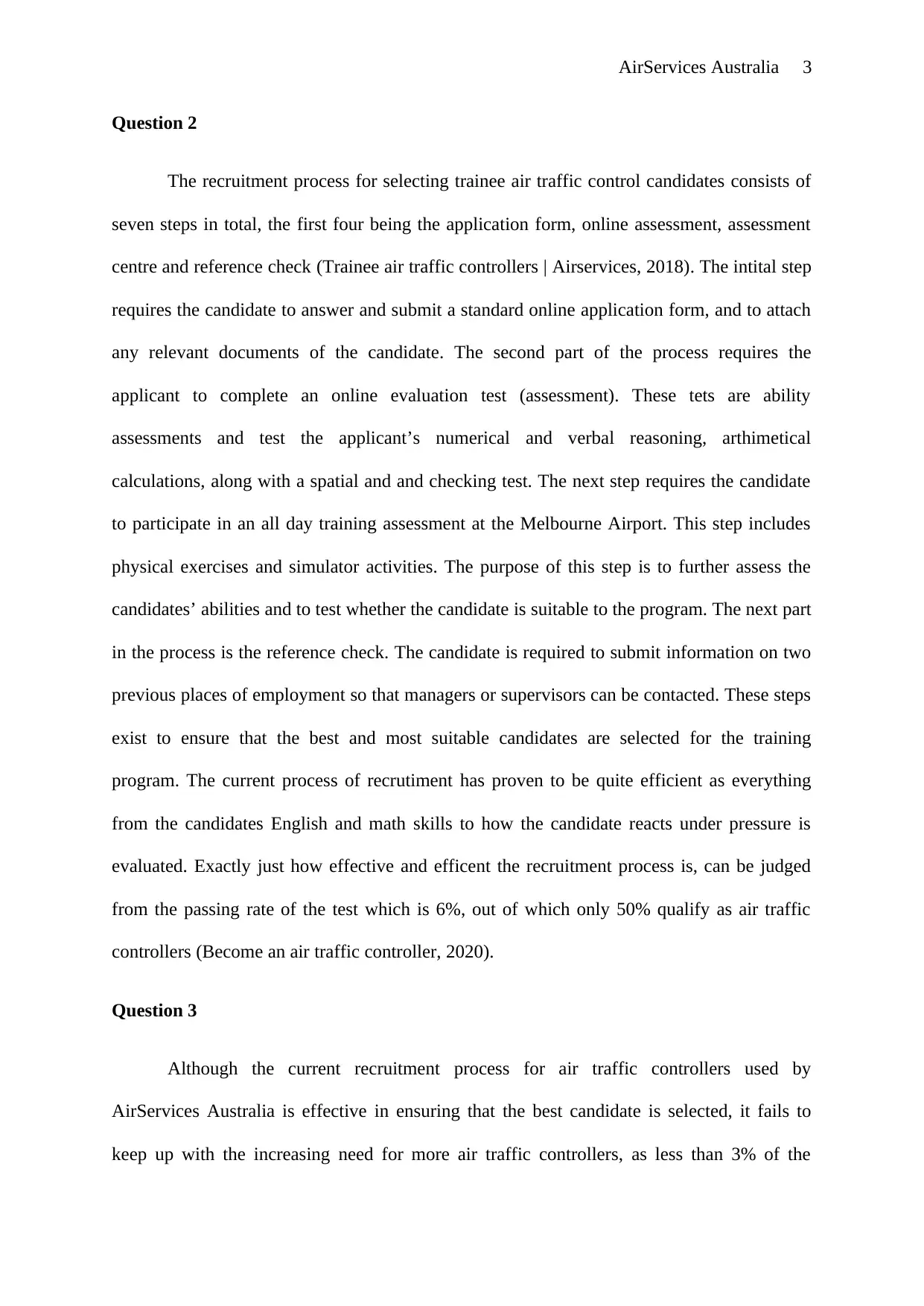
AirServices Australia 3
Question 2
The recruitment process for selecting trainee air traffic control candidates consists of
seven steps in total, the first four being the application form, online assessment, assessment
centre and reference check (Trainee air traffic controllers | Airservices, 2018). The intital step
requires the candidate to answer and submit a standard online application form, and to attach
any relevant documents of the candidate. The second part of the process requires the
applicant to complete an online evaluation test (assessment). These tets are ability
assessments and test the applicant’s numerical and verbal reasoning, arthimetical
calculations, along with a spatial and and checking test. The next step requires the candidate
to participate in an all day training assessment at the Melbourne Airport. This step includes
physical exercises and simulator activities. The purpose of this step is to further assess the
candidates’ abilities and to test whether the candidate is suitable to the program. The next part
in the process is the reference check. The candidate is required to submit information on two
previous places of employment so that managers or supervisors can be contacted. These steps
exist to ensure that the best and most suitable candidates are selected for the training
program. The current process of recrutiment has proven to be quite efficient as everything
from the candidates English and math skills to how the candidate reacts under pressure is
evaluated. Exactly just how effective and efficent the recruitment process is, can be judged
from the passing rate of the test which is 6%, out of which only 50% qualify as air traffic
controllers (Become an air traffic controller, 2020).
Question 3
Although the current recruitment process for air traffic controllers used by
AirServices Australia is effective in ensuring that the best candidate is selected, it fails to
keep up with the increasing need for more air traffic controllers, as less than 3% of the
Question 2
The recruitment process for selecting trainee air traffic control candidates consists of
seven steps in total, the first four being the application form, online assessment, assessment
centre and reference check (Trainee air traffic controllers | Airservices, 2018). The intital step
requires the candidate to answer and submit a standard online application form, and to attach
any relevant documents of the candidate. The second part of the process requires the
applicant to complete an online evaluation test (assessment). These tets are ability
assessments and test the applicant’s numerical and verbal reasoning, arthimetical
calculations, along with a spatial and and checking test. The next step requires the candidate
to participate in an all day training assessment at the Melbourne Airport. This step includes
physical exercises and simulator activities. The purpose of this step is to further assess the
candidates’ abilities and to test whether the candidate is suitable to the program. The next part
in the process is the reference check. The candidate is required to submit information on two
previous places of employment so that managers or supervisors can be contacted. These steps
exist to ensure that the best and most suitable candidates are selected for the training
program. The current process of recrutiment has proven to be quite efficient as everything
from the candidates English and math skills to how the candidate reacts under pressure is
evaluated. Exactly just how effective and efficent the recruitment process is, can be judged
from the passing rate of the test which is 6%, out of which only 50% qualify as air traffic
controllers (Become an air traffic controller, 2020).
Question 3
Although the current recruitment process for air traffic controllers used by
AirServices Australia is effective in ensuring that the best candidate is selected, it fails to
keep up with the increasing need for more air traffic controllers, as less than 3% of the
⊘ This is a preview!⊘
Do you want full access?
Subscribe today to unlock all pages.

Trusted by 1+ million students worldwide
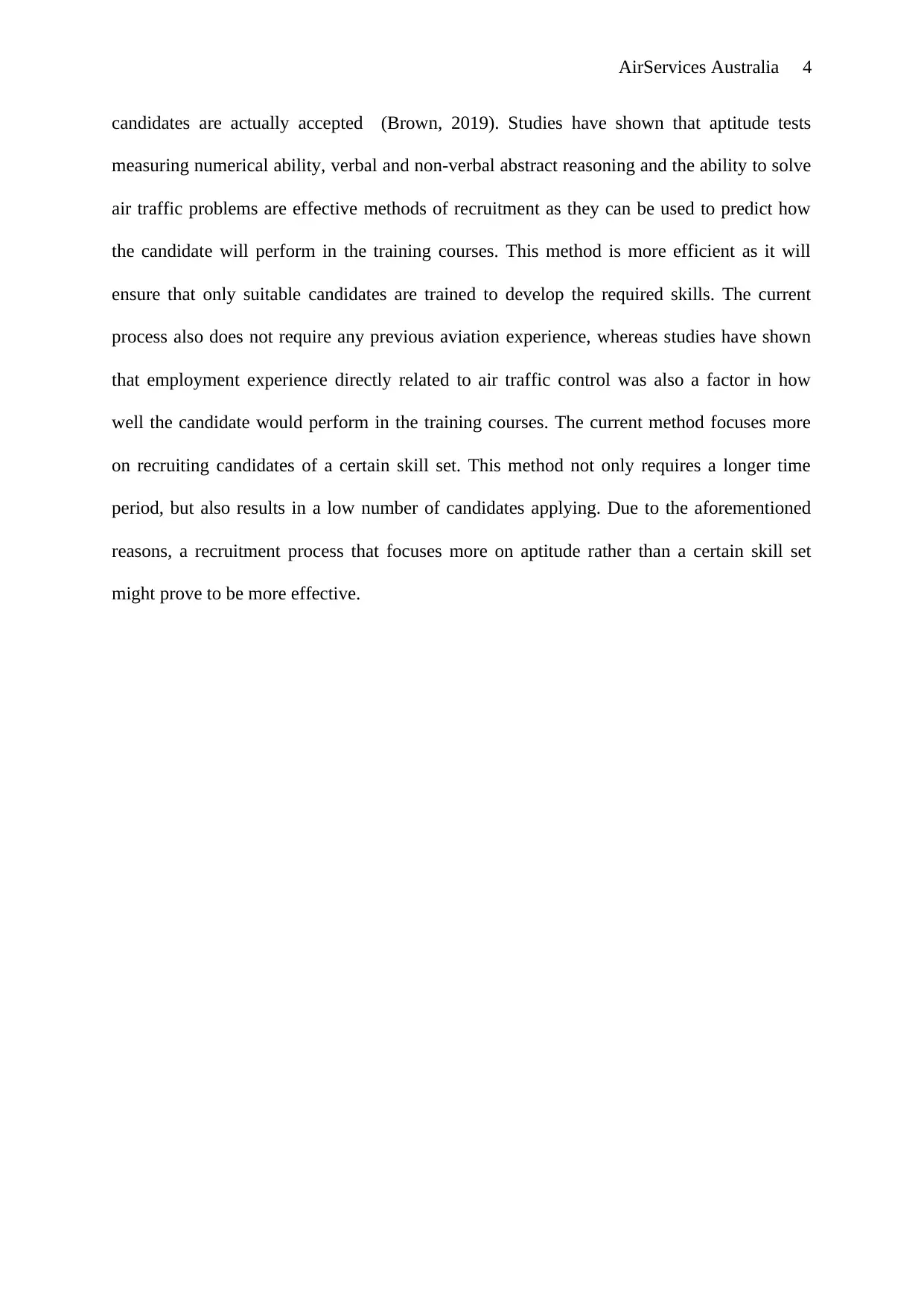
AirServices Australia 4
candidates are actually accepted (Brown, 2019). Studies have shown that aptitude tests
measuring numerical ability, verbal and non-verbal abstract reasoning and the ability to solve
air traffic problems are effective methods of recruitment as they can be used to predict how
the candidate will perform in the training courses. This method is more efficient as it will
ensure that only suitable candidates are trained to develop the required skills. The current
process also does not require any previous aviation experience, whereas studies have shown
that employment experience directly related to air traffic control was also a factor in how
well the candidate would perform in the training courses. The current method focuses more
on recruiting candidates of a certain skill set. This method not only requires a longer time
period, but also results in a low number of candidates applying. Due to the aforementioned
reasons, a recruitment process that focuses more on aptitude rather than a certain skill set
might prove to be more effective.
candidates are actually accepted (Brown, 2019). Studies have shown that aptitude tests
measuring numerical ability, verbal and non-verbal abstract reasoning and the ability to solve
air traffic problems are effective methods of recruitment as they can be used to predict how
the candidate will perform in the training courses. This method is more efficient as it will
ensure that only suitable candidates are trained to develop the required skills. The current
process also does not require any previous aviation experience, whereas studies have shown
that employment experience directly related to air traffic control was also a factor in how
well the candidate would perform in the training courses. The current method focuses more
on recruiting candidates of a certain skill set. This method not only requires a longer time
period, but also results in a low number of candidates applying. Due to the aforementioned
reasons, a recruitment process that focuses more on aptitude rather than a certain skill set
might prove to be more effective.
Paraphrase This Document
Need a fresh take? Get an instant paraphrase of this document with our AI Paraphraser
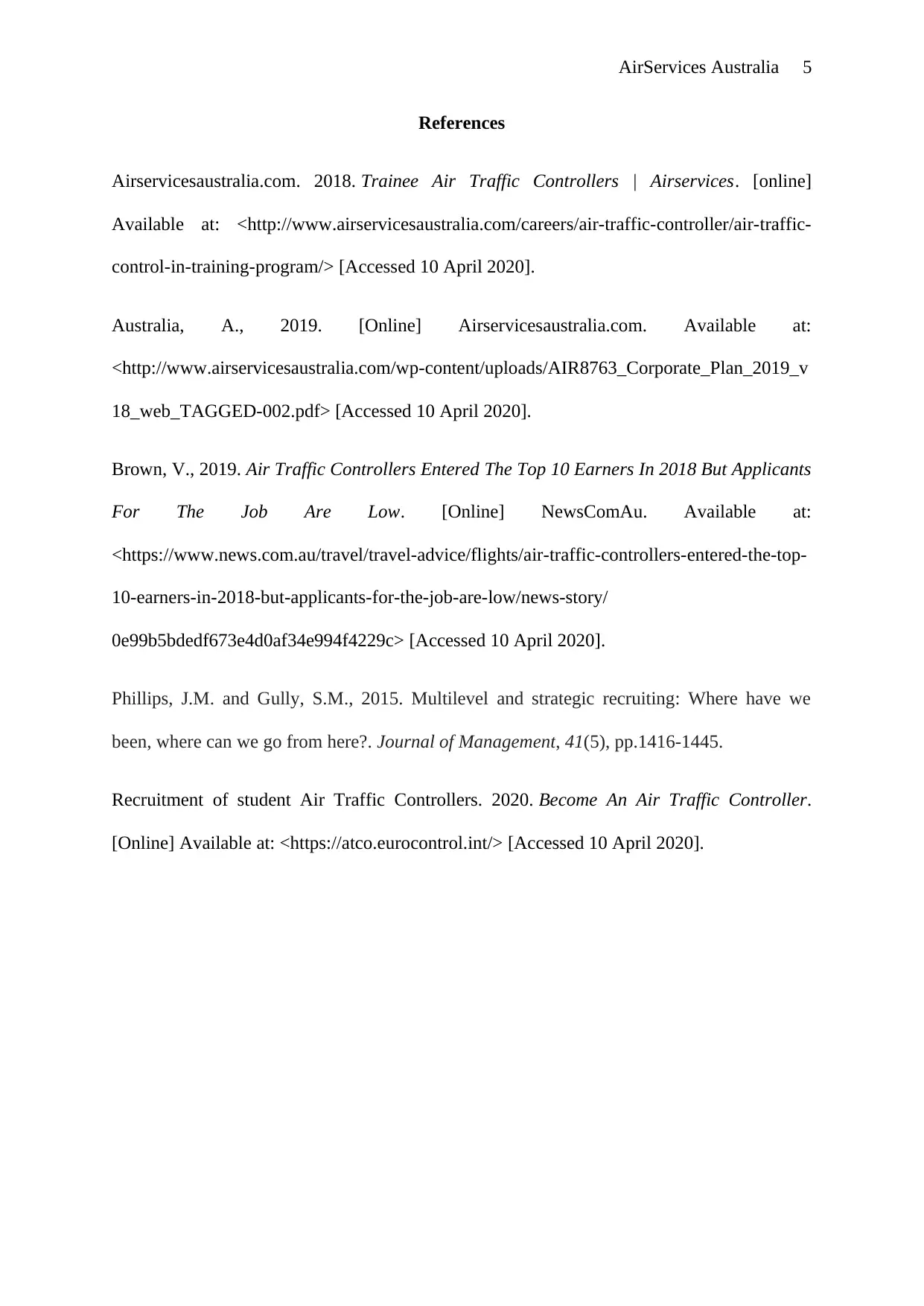
AirServices Australia 5
References
Airservicesaustralia.com. 2018. Trainee Air Traffic Controllers | Airservices. [online]
Available at: <http://www.airservicesaustralia.com/careers/air-traffic-controller/air-traffic-
control-in-training-program/> [Accessed 10 April 2020].
Australia, A., 2019. [Online] Airservicesaustralia.com. Available at:
<http://www.airservicesaustralia.com/wp-content/uploads/AIR8763_Corporate_Plan_2019_v
18_web_TAGGED-002.pdf> [Accessed 10 April 2020].
Brown, V., 2019. Air Traffic Controllers Entered The Top 10 Earners In 2018 But Applicants
For The Job Are Low. [Online] NewsComAu. Available at:
<https://www.news.com.au/travel/travel-advice/flights/air-traffic-controllers-entered-the-top-
10-earners-in-2018-but-applicants-for-the-job-are-low/news-story/
0e99b5bdedf673e4d0af34e994f4229c> [Accessed 10 April 2020].
Phillips, J.M. and Gully, S.M., 2015. Multilevel and strategic recruiting: Where have we
been, where can we go from here?. Journal of Management, 41(5), pp.1416-1445.
Recruitment of student Air Traffic Controllers. 2020. Become An Air Traffic Controller.
[Online] Available at: <https://atco.eurocontrol.int/> [Accessed 10 April 2020].
References
Airservicesaustralia.com. 2018. Trainee Air Traffic Controllers | Airservices. [online]
Available at: <http://www.airservicesaustralia.com/careers/air-traffic-controller/air-traffic-
control-in-training-program/> [Accessed 10 April 2020].
Australia, A., 2019. [Online] Airservicesaustralia.com. Available at:
<http://www.airservicesaustralia.com/wp-content/uploads/AIR8763_Corporate_Plan_2019_v
18_web_TAGGED-002.pdf> [Accessed 10 April 2020].
Brown, V., 2019. Air Traffic Controllers Entered The Top 10 Earners In 2018 But Applicants
For The Job Are Low. [Online] NewsComAu. Available at:
<https://www.news.com.au/travel/travel-advice/flights/air-traffic-controllers-entered-the-top-
10-earners-in-2018-but-applicants-for-the-job-are-low/news-story/
0e99b5bdedf673e4d0af34e994f4229c> [Accessed 10 April 2020].
Phillips, J.M. and Gully, S.M., 2015. Multilevel and strategic recruiting: Where have we
been, where can we go from here?. Journal of Management, 41(5), pp.1416-1445.
Recruitment of student Air Traffic Controllers. 2020. Become An Air Traffic Controller.
[Online] Available at: <https://atco.eurocontrol.int/> [Accessed 10 April 2020].
1 out of 5
Related Documents
Your All-in-One AI-Powered Toolkit for Academic Success.
+13062052269
info@desklib.com
Available 24*7 on WhatsApp / Email
![[object Object]](/_next/static/media/star-bottom.7253800d.svg)
Unlock your academic potential
Copyright © 2020–2025 A2Z Services. All Rights Reserved. Developed and managed by ZUCOL.




